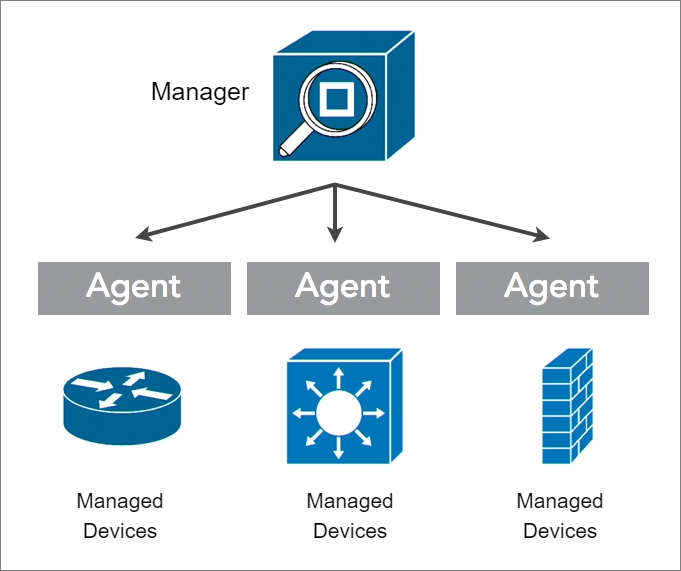SNMP
Overview
Simple Network Management Protocol (SNMP) is a widely used protocol for network management and monitoring. It allows network administrators to remotely monitor and manage network devices, such as routers, switches, servers, and printers, from a central management station.
- Collects and reports information about device performance.
- Enables remote configuration of network devices.
- Generates alerts and notifications based on predefined conditions or thresholds.
- Provide real-time data and historical logs for analysis.
- Authentication and access control mechanisms.
Sample diagram:

Components
The common components:
-
SNMP Manager
- Also known as the Management Information Base (MIB)
- Responsible for monitoring and managing network devices.
- It runs SNMP management software.
- Management station, a master node that can send and receive.
-
Agent
- Software embedded in network devices.
- Collects and reports information to the management station.
-
Managed Device
- Network devices, such as routers, switches, and servers.
- Devices monitored and managed using SNMP.
How it looks like:

Operations
The SNMP Manager can send and receive messages to the agents using three message types;
-
Set
- Modifies configuration settings on a managed device.
- Updating parameters or enabling/disabling features.
- Agents receive this and changes the variable.
- After changing, agents responds to manager with the new values.
-
Get
- Retrieves information from a managed device.
- Details such as system configuration or performance data.
-
Trap
- Sent asynchronously, unsolicited notifications from agents to the server.
- Agent send them without being requested by the manager.
- Allows agents to notify the manager in near real time.
- Used to provide events or alarm notifications to the manager.
- Can include:
- Uptime
- Configuration changes
- Unexpected downtime
- Other essential information
Types of Trap Messages
-
Granular
- Sent trap messages get a unique objective identifier (OID).
- Distinguishes each message as a unique message received.
- OIDs are consolidated and stored inside a translation file called MIB.
-
Verbose
- May be configured to contain all information about an alert or event.
- More data is sent, taking up more resources and bandwidth.
Management Information Base
Used to describe the structure of the management data of a device subsystem using a hierarchical namespace containing object identifiers.
- Allows the trap messages to send just the changes for the specific OID.
- Saves bandwidth because SNMP traps don't send redundant information.
Variable-binding
Data in SNMP traps are stored in a simple key-value pair configuration known as variable-binding. Sample:
Site: Main-HQ
Criticality: High
Severity: Low
Alarm Description: High Temperature
Versions
There are three SNMP versions with varying security:
-
SNMPv1
- The original version of SNMP
- Basic functionality and limited security features.
-
SNMPv2
- Introduced improvements in performance.
- Added new features, such as bulk retrieval operations.
-
SNMPv3
- The most recent version, offering enhanced security features.
- Encryption and authentication mechanisms.
Both SNMPv1 and SNMPv2 uses a community strings to access the managed devices.
- Strings are stored as insecure plain text.
- Default community string are either public (read-only) or private (read-write).
In SNMPv3, three enhancements are added to ensure integrity and confidetiality.
- Messages are hashed before being sent.
- Source of the messages is validated.
- Uses DES with a 56-bit encryption key
- DES is being replaced by 3DES and AES in newer devices
Another benefit of SNMPv3 is it groups the SNMP components into different entities with different authorization and access privileges.
